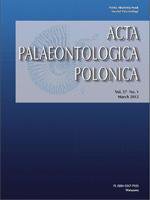A new neotenic salamander, Seminobatrachus boltyschkensis gen. et sp. nov., is described based on 14 skeletons of late Paleocene—early Eocene age preserved on drill core slabs from the Cherkassy Region, central Ukraine. The new taxon is diagnosed by the following unique combination of characters: dorsal process of premaxilla posteriorly elongate and overlaps frontal; maxilla greatly reduced in size; parietal—squamosal contact absent; vomerine tooth row long and parallel to maxillary arcade; pterygoid has long anterior process; quadrate ossified; marginal and palatal teeth pedicellate; trunk vertebrae amphicoelous, each having a subcentral keel, anterior basapophysis, and spinal nerve foramina; ribs bicipital; carpals and tarsals unossified; and phalangeal formulae of 2-2-3-2 and 2-2-3-4-2 for manus and pes, respectively. Phylogenetic analysis nests S. boltyschkensis within Urodela (i.e., crown-clade salamanders), but its exact phylogenetic position is equivocal, resolving in one of three ways: (1) in an unresolved trichotomy with Salamandra and (Ambystomatidae (Dicamptodon Rhyacotriton)) (results obtained in NONA v. 2.0, with the WINCLADA v. 1.00.08 interface; the parsimony ratchet (island hopper) algorithm), (2) as a sister taxon of (Salamandra (Ambystomatidae (Dicamptodon Rhyacotriton))) clade (results obtained in TNT v. 1.1; the implicit enumeration search algorithm) or (3) as a sister taxon of Ambystomatidae (results obtained in PAUP v. 4.0b10; the branch-and-bound search algorithm).
How to translate text using browser tools
1 March 2012
A New Salamander from the Late Paleocene—Early Eocene of Ukraine
Pavel P. Skutschas,
Yuri M. Gubin

Acta Palaeontologica Polonica
Vol. 57 • No. 1
March 2012
Vol. 57 • No. 1
March 2012
Caudata
Eocene
Paleocene
phylogeny
Ukraine
Urodela




